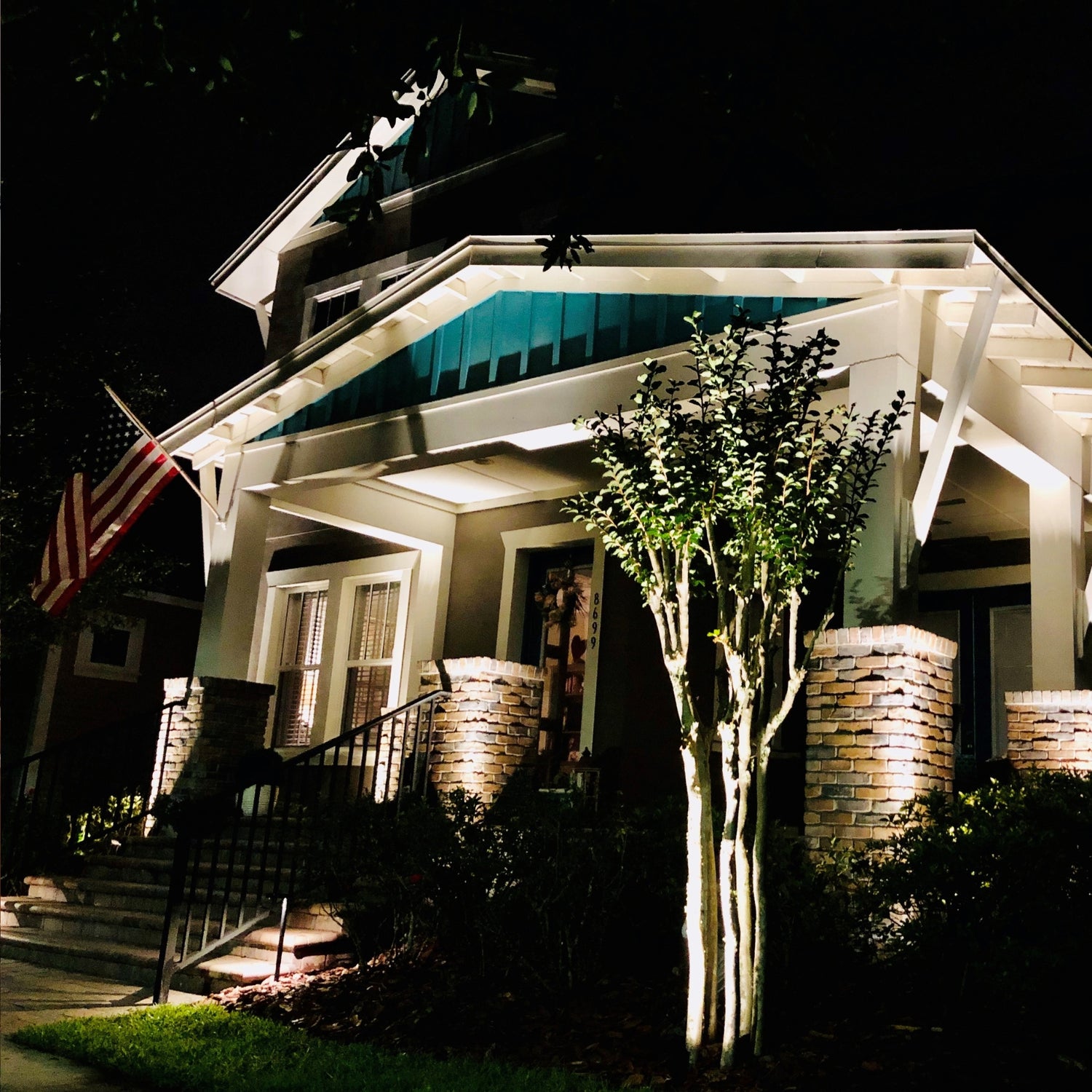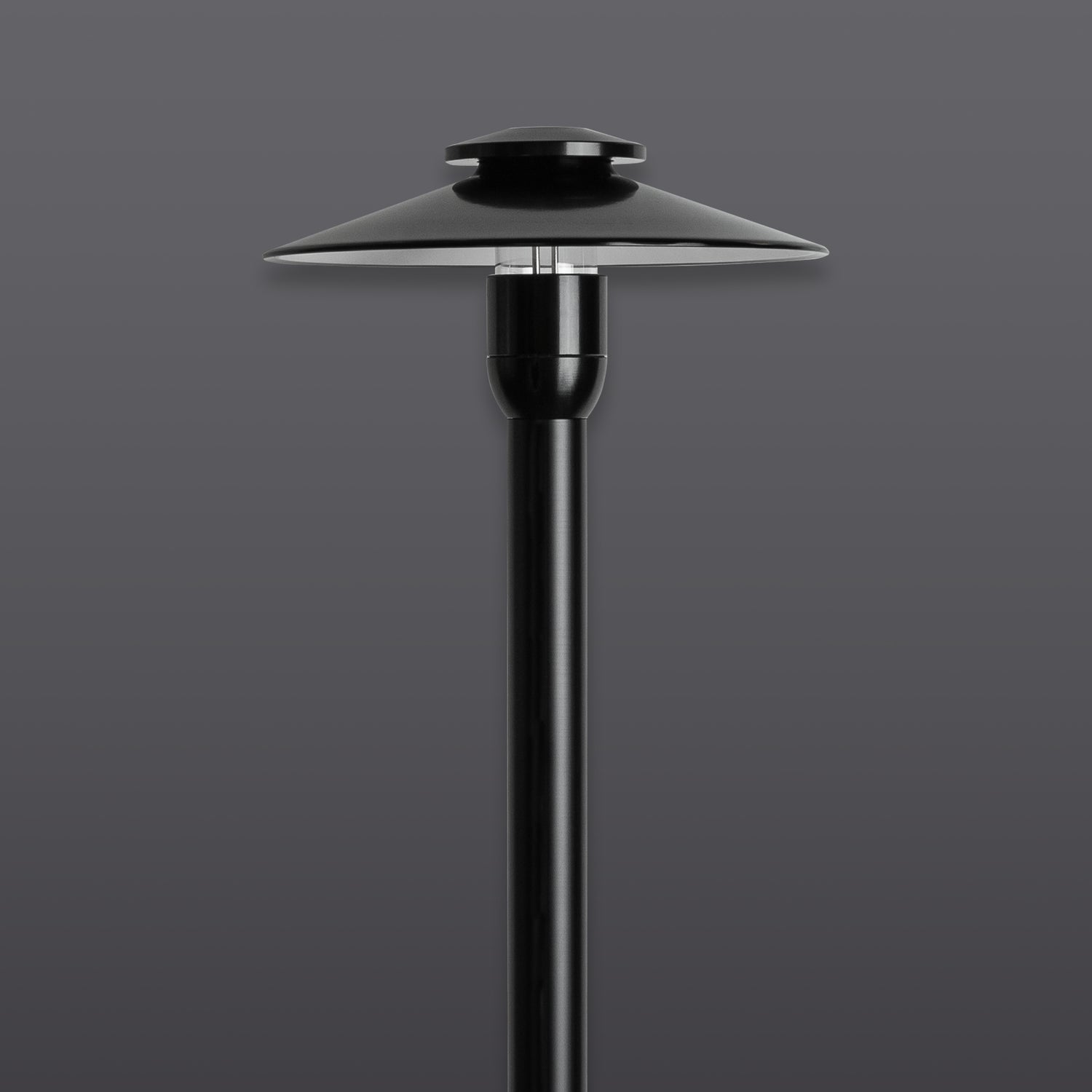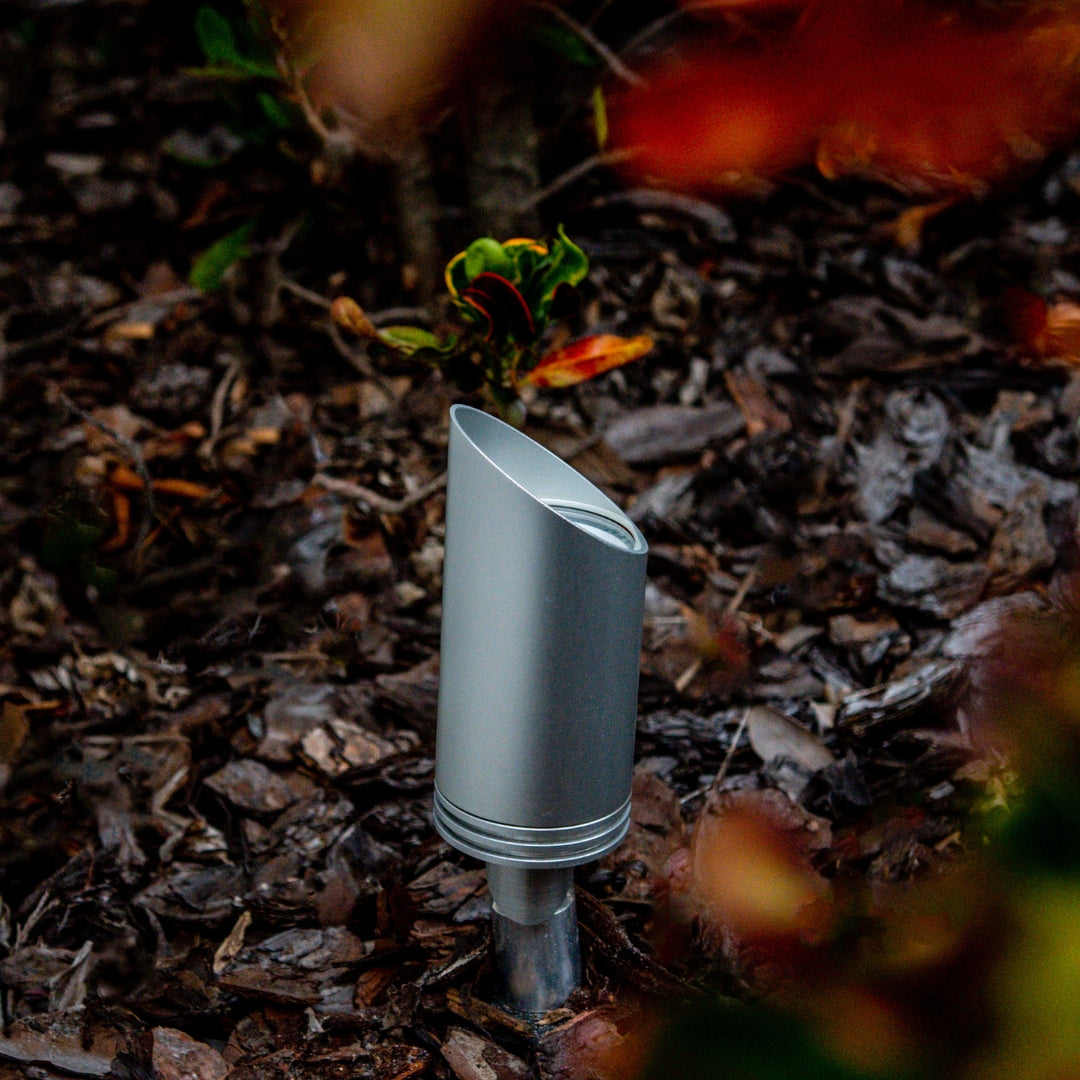How To Start An Outdoor Landscape Lighting Business
Starting an outdoor landscape lighting business is an excellent idea for entrepreneurs who appreciate the autonomy of running their own business as well as the value of elevating the beauty of outdoor spaces within your community.
When starting a landscape lighting company, it's important to understand the market, develop appropriate skills, and lay the stable foundation for your business through marketing, sales, and financial planning.
The outdoor lighting industry is growing and new technologies like wireless RGBW lighting, integrated drop-in lighting and permanent outdoor lighting are innovations already driving significant interest in communities around the country. By starting an outdoor landscape lighting business, you can tap into this demand and build a stable and rewarding career.
To help you get your landscape lighting business off the ground, consider the 10-step roadmap to building a successful outdoor landscape lighting business below. Also, join Team Americana — a network of landscape light installers who offer Americana Outdoor Lighting's reliable and trusted outdoor lights.
- Step 1: Understand Your Landscape Lighting Market
- Step 2: Develop an Outdoor Lighting Business Plan
- Step 3: Legal and Administrative Setup
- Step 4: Technical Skills and Training
- Step 5: Marketing and Sales
- Step 6: Operations and Project Management
- Step 7: Expanding Your Outdoor Services
- Step 8: Financial Management
- Step 9: Building Customer Relationships
- Step 10: Scaling Your Landscape Lighting Business
Step 1: Understand Your Landscape Lighting Market
Before starting any business, let alone an outdoor lighting business, you need to truly understand the market within which you intend to operate. Are there too many competitors offering landscape lighting? Are homeowners looking for better outdoor lighting solutions?
The answers to these questions will guide the viability of a landscape lighting business in your area as well as providing you with more context around the risks and opportunites of starting an outdoor landscape lighting business.
Size and Scope of the Outdoor Lighting Industry
The outdoor lighting industry is a substantial segment of the broader lighting market, encompassing residential, commercial, and industrial applications. It's nearly a multi-million dollar industry, reflecting the significant investment homeowners and businesses make to enhance outdoor aesthetics, functionality, and security. With the Department of Energy estimating that about 25% of all electricity produced in the US is used for lighting, and approximately 10% dedicated to outdoor and landscaping purposes, the potential market for outdoor lighting solutions is vast and varied.
Importance of Outdoor Lighting for Homes and Businesses
Outdoor lighting serves multiple purposes beyond mere illumination. For homes, it enhances curb appeal, creates a welcoming atmosphere, and increases safety by lighting walkways and deterring potential intruders. Businesses use outdoor lighting to highlight architectural features, improve customer experience, and ensure employee and customer safety in parking lots and walkways. Moreover, well-designed outdoor lighting projects contribute to property value and can significantly impact occupancy rates and retail sales, making it a worthwhile investment for residential and commercial property owners alike.
Trends in Outdoor Lighting Technology
The outdoor lighting industry has seen rapid technological advancements, particularly with the advent of Light Emitting Diodes (LEDs). LEDs have revolutionized outdoor lighting with their efficiency, durability, and lower operational costs. Unlike traditional lighting options, LEDs offer longer lifespans, reduced energy consumption, and better quality of light, which can be tailored to specific outdoor environments. Innovations in thermal management, optics, chip technology, and controls have made LEDs a versatile choice for outdoor lighting. Moreover, smart outdoor lighting systems integrated with IoT (Internet of Things) technologies are becoming increasingly popular, allowing users to customize lighting scenes, schedules, and remotely control lighting systems, further driving the market towards energy-efficient and intelligent lighting solutions.
Case Studies of Successful Outdoor Lighting Projects
-
Residential Landscape Lighting: A case study of a high-end residential property that used LED fixtures to highlight landscaping features, paths, and architectural details. The project involved a comprehensive lighting design that included accent, task, and ambient lighting to create a cohesive and inviting outdoor space. The use of LEDs resulted in significant energy savings and enhanced the property's aesthetic and security features.
-
Commercial Plaza Lighting: This case study showcases a commercial plaza that implemented a smart LED outdoor lighting system. The system was designed to improve visibility and safety in parking areas, walkways, and common areas, with motion sensors and dimming capabilities to reduce energy consumption during off-peak hours. The project demonstrated the effectiveness of integrating technology with outdoor lighting for commercial applications, leading to improved operational efficiency and customer satisfaction.
-
Public Park Illumination: Highlighting the transformation of a public park using energy-efficient LED lighting to enhance safety and extend park hours. The lighting design focused on illuminating pathways, landmarks, and recreational areas, creating a welcoming environment for community activities. The project emphasized the role of outdoor lighting in promoting public safety and encouraging community engagement.
-
Historical Building Facade Lighting: A project that involved the architectural lighting of a historical building to accentuate its features and improve nighttime aesthetics. The project utilized LED fixtures with adjustable color temperatures and intensities to highlight the building's architectural details without causing damage or detracting from its historical significance. This case study exemplifies how modern lighting technologies can be sensitively applied to heritage conservation.
These case studies illustrate the diversity of outdoor lighting applications and the potential for innovative, efficient, and effective lighting designs to meet aesthetic, functional, and safety needs in various settings. They serve as inspiration for new entrants into the outdoor lighting industry, demonstrating the importance of understanding customer needs, technological trends, and the impact of well-executed lighting projects.
Step 2: Develop an Outdoor Lighting Business Plan
After researching your market, competition, and other areas of landscape lighting in your area, it's time to start creating a strategy for starting and running your landscape lighting business.
An outdoor lighting business plan is not a one-time document, it should be an evolving blueprint that serves as your north star. By frequently reviewing and updating your business plan, you can stay on track and moving towards a research-driven strategic direction.
Crafting a Detailed Business Plan for Your Outdoor Lighting Venture
A comprehensive business plan is the cornerstone of a successful outdoor lighting business. It should outline your business's objectives, strategies, market analysis, operational structure, and financial projections. The plan must include an executive summary, a detailed description of your services, an analysis of the outdoor lighting market, marketing and sales strategies, and a detailed financial plan. This document will serve not only as a roadmap for your business but also as a tool to attract investors or secure financing.
Determining Your Target Market: Residential vs. Commercial Clients
After researching your market, competition, and other areas of landscape lighting in your area, it's time to start creating a strategy for starting and running your landscape lighting business.
An outdoor lighting business plan is not a one-time document, it should be an evolving blueprint that serves as your north star. By frequently reviewing and updating your business plan, you can stay on track and moving towards a research-driven strategic direction.
Crafting a Detailed Business Plan for Your Outdoor Lighting Venture
A comprehensive business plan is the cornerstone of a successful outdoor lighting business. It should outline your business's objectives, strategies, market analysis, operational structure, and financial projections. The plan must include an executive summary, a detailed description of your services, an analysis of the outdoor lighting market, marketing and sales strategies, and a detailed financial plan. This document will serve not only as a roadmap for your business but also as a tool to attract investors or secure financing.
Determining Your Target Market: Residential vs. Commercial Clients
Identifying your target market is crucial for tailoring your marketing efforts and services. Residential clients may seek to enhance the aesthetics of their property, improve safety, or increase its value. Commercial clients, including businesses and public spaces, often focus on creating inviting outdoor environments, enhancing security, and adhering to lighting regulations. Each market has distinct needs and requires different marketing approaches, installation techniques, and service offerings.
Startup Costs and Financial Planning
Startup costs can vary widely depending on the scale of your operation and the services you intend to offer. Initial expenses typically include licensing and permits, insurance, equipment, inventory, marketing, and potentially a vehicle for transportation. Financial planning should account for these startup costs, ongoing operational expenses, and projections for revenue and profit. It's crucial to have a financial buffer for unexpected expenses and a clear strategy for achieving profitability.
Equipment and Inventory Considerations
The quality of your equipment and inventory can significantly impact the services you provide. Initial investments may include lighting fixtures, wiring, control systems, tools for installation, and testing equipment. Choosing high-quality, durable, and efficient products is essential, as is establishing good relationships with suppliers for the best pricing and support. Inventory management will be crucial to ensure you have the necessary items on hand for projects while minimizing excess stock.
Setting Your Pricing Strategy
Your pricing strategy should reflect the quality of your services, cover your costs, and ensure a healthy profit margin. Factors to consider include the cost of materials, labor, overheads, and the complexity of the installation. Competitive pricing analysis can help identify a pricing model that is competitive yet profitable. Offering a range of services from basic to premium packages can cater to different client budgets and needs. Transparent pricing and providing detailed quotes can help build trust with your clients.
Marketing and Sales Strategies
A solid marketing strategy will help you reach your target audience and differentiate your services from competitors. This could include online marketing, social media engagement, partnerships with local businesses, attending trade shows, and word-of-mouth referrals. Highlighting your expertise, showcasing successful projects, and emphasizing the quality and reliability of your services are key to attracting new clients. Sales strategies may involve personalized consultations, creating compelling proposals, and excellent customer service to convert inquiries into sales.
Operational Structure and Management
Define the operational structure of your business, including roles and responsibilities, customer service processes, project management, and quality control measures. Efficient operations can improve project turnaround times, enhance customer satisfaction, and increase profitability. Consider using project management and CRM tools to streamline processes and improve communication with clients.
Financial Projections and Funding
Include detailed financial projections in your business plan, covering expected revenue, expenses, and cash flow for at least the first three years. This section should demonstrate the viability of your business and your strategy for growth. If external funding is required, explore options such as loans, grants, or investors, and be prepared to present your business plan to potential funders.
Creating a thorough business plan for your outdoor lighting venture requires careful thought and research. It not only guides your business decisions but also positions your company for success in the competitive outdoor lighting market.
Step 3: Legal and Admin Setup
You'll also need to acquire any necessary business or trade licensing to operate a business in your city. Beyond the mandatory licenses, you may want to acquire trade-specific certifications that can differentiate your from your competitors while also equipping you with more knowledge and skills needed to do your job better.
Obtaining Necessary Licenses and Permits
Before launching an outdoor lighting business, it's imperative to understand and comply with local, state, and federal regulations. This means obtaining the necessary licenses and permits to legally operate. Depending on your location, this could include a general business license, a contractor's license (specifically for electrical work, in some cases), and permits for specific projects. Researching your local Secretary of State's website and consulting with a legal professional can ensure you meet all legal requirements.
Choosing a Business Structure
Selecting the right business structure is critical for tax purposes, personal liability, and the overall operation of your company. The options include:
- Sole Proprietorship: Simplest form, but personal and business assets are not separated, increasing personal risk.
- Limited Liability Company (LLC): Offers liability protection, separating personal and business assets, while providing flexible tax options.
- Corporation (S-Corp, C-Corp): More complex, suitable for larger businesses, offering strong protection but with more regulatory requirements.
- Partnership: For businesses with multiple owners, detailing how decisions are made, profits are shared, and more.
Consulting with a legal or financial advisor can help determine the best structure based on your business goals, size, and risk tolerance.
Insurance Needs for Outdoor Lighting Businesses
Insurance is crucial to protect your business, employees, and clients. Types of insurance to consider include:
- General Liability Insurance: Covers third-party property damage and injury claims.
- Professional Liability Insurance: Protects against claims of negligence or failure to perform.
- Workers' Compensation: Mandatory in most states if you have employees, covering job-related injuries or illnesses.
- Commercial Auto Insurance: Necessary if you use vehicles for business purposes.
- Tools and Equipment Insurance: Protects your business property in transit or at job sites.
It's advisable to work with an insurance agent who understands the outdoor lighting industry to ensure you have adequate coverage.
Hiring and Training Employees
As your business grows, you may need to hire employees to manage increasing project demands. Hiring entails several key steps:
- Defining Roles: Clearly outline job descriptions, responsibilities, and qualifications.
- Recruitment: Use job boards, social media, and industry contacts to find candidates.
- Screening and Interviewing: Ensure candidates have the necessary skills, experience, and fit with your company culture.
- Training: Develop a comprehensive training program covering technical skills, safety protocols, and customer service standards.
Consider employment laws regarding wages, benefits, workplace safety, and nondiscrimination. Establishing an employee handbook outlining policies and procedures can help manage your team effectively.
Step 4: Landscape Lighting Skills and Knowledge
Fortunately, if you're starting a low-voltage outdoor light installation company, you won't need any formal degree — just the technical knowledge and skills needed to install lighting systems safely and effectively. There are many ways for you to develop yourself into a professional landscape light installer.
Fundamental Electrical Skills Required
While most U.S. areas will not require a licensed electrician to install low-volt outdoor landscape lighting, a fundamental understanding of electrical systems is important for a landscape lighting business.
- Electrical Theory: Understanding the basics of voltage, current, resistance, and how electricity flows through different types of circuits.
- Safety Practices: Knowing how to work safely with electricity, including the proper use of personal protective equipment (PPE), understanding electrical codes, and recognizing the hazards associated with electrical work.
- Wiring Techniques: Mastery in connecting wires, using various connectors and terminals, and ensuring secure and safe connections that comply with electrical codes.
- Troubleshooting: The ability to diagnose and fix electrical problems efficiently, which requires a deep understanding of outdoor lighting systems and their components.
Understanding Different Types of Outdoor Lighting Fixtures and Their Applications
A successful outdoor lighting designer must be familiar with a wide range of lighting fixtures and their best use cases. These include:
- Path Lights: For illuminating walkways and paths, enhancing safety and visual appeal.
- Spotlights and Floodlights: Used to highlight architectural features, trees, or sculptures.
- Deck and Patio Lights: Enhance the usability of outdoor living spaces after dark.
- Underwater Lights: Illuminate pools, fountains, and water features, adding a magical element to the landscape.
- Motion Sensor Lights: Improve security by illuminating areas when movement is detected.
Each type of fixture has its own installation nuances, electrical requirements, and optimal placement strategies to achieve the desired effect.
Design Principles for Effective Outdoor Lighting
Creating effective outdoor lighting designs requires more than technical skills; it involves artistic vision and an understanding of design principles such as:
- Layering: Using a combination of ambient, task, and accent lighting to create depth and interest.
- Balance: Achieving a visually pleasing distribution of light, avoiding over-illumination or dark spots.
- Focus: Directing attention to key elements of the landscape or architecture while maintaining overall harmony.
- Color Temperature: Choosing the right color temperatures for different settings to enhance mood and aesthetics.
Resources for Ongoing Training and Education in Outdoor Lighting Design
To stay at the forefront of outdoor lighting design and technology, it's crucial to engage in ongoing training and education. Resources include:
- Professional Associations: Organizations like the International Landscape Lighting Institute (ILLI) and the Association of Outdoor Lighting Professionals (AOLP) offer workshops, certifications, and networking opportunities.
- Trade Shows and Conferences: Events like LIGHTFAIR International provide a platform to learn about the latest industry trends, technologies, and best practices.
- Online Courses and Webinars: Many manufacturers and industry groups offer online training sessions on new products, design techniques, and business practices.
- Technical Manuals and Guides: Keeping a library of reference materials on electrical codes, lighting design, and product specifications can be invaluable.
Step 5: Outdoor Lighting Marketing and Sales
As with any business, your landscape lighting company needs to devote time, money, and effort into marketing your new business and developing your sales techniques.
Building a Strong Brand Identity
To differentiate your outdoor lighting business in a competitive market, developing a unique and memorable brand identity is crucial. This encompasses your company's name, logo, color scheme, and the overall message you wish to convey. Your brand should reflect the quality, reliability, and creativity of your services, resonating with your target audience. Consistency across all marketing materials and communications strengthens your brand identity, making your business more recognizable and trusted by potential clients.
Effective Online and Offline Marketing Strategies
Your marketing strategy should be a mix of both online and offline approaches to reach a broader audience.
- Online Marketing:
- Website: Your business's online hub should be professional, easy to navigate, and optimized for search engines (SEO) to attract more visitors. Include a portfolio of past projects, testimonials, a blog with helpful lighting tips, and a contact form.
- Social Media: Platforms like Instagram and Facebook are perfect for showcasing your work through before-and-after photos, sharing customer testimonials, and engaging with your community.
- Email Marketing: Collect emails from your website and social media to send out newsletters, promotions, and updates about your services to keep your audience engaged.
- Offline Marketing:
- Networking: Attend local home and garden shows, join business associations, and network with contractors, landscapers, and architects who can refer clients to you.
- Direct Mail: Send brochures or postcards to targeted neighborhoods or commercial areas where your services might be needed.
- Vehicle Branding: Wrap your company vehicles with your logo and contact information to serve as mobile billboards.
Crafting Persuasive Sales Pitches and Proposals
Your sales pitch and proposals should clearly articulate the value your outdoor lighting services bring to a property, such as enhanced beauty, increased safety, and improved property value. Tailor your pitch to address the specific needs or pain points of each potential client. Provide clear, detailed proposals that outline the scope of work, the products to be used, pricing, and the expected outcomes. Including visual elements like design mock-ups or photos of similar projects can help clients visualize the end result.
Leveraging Social Media and Digital Marketing
Social media and digital marketing are powerful tools to increase your visibility and attract new clients.
- Social Media: Regularly post engaging content that showcases your expertise and highlights your projects. Use hashtags, participate in relevant groups, and engage with your followers to increase your reach.
- SEO and Local SEO: Optimize your website and content with keywords related to outdoor lighting services to improve your search engine ranking. Make sure your business is listed in local directories and on Google My Business to improve local search visibility.
- Online Advertising: Consider paid advertising options like Google AdWords or Facebook Ads to target potential clients in your area. Use retargeting ads to stay top of mind with website visitors who haven't yet converted.
By implementing these marketing and sales strategies, you can build a strong presence for your outdoor lighting business, attract new clients, and grow your company.
Step 6: Operations and Project Management
As you begin attracting clients and taking on jobs, you'll need to prioritize good management of those lighting projects.
Managing the Logistics of Outdoor Lighting Installations
To ensure the smooth execution of outdoor lighting projects, effective logistical management is paramount. This includes precise planning from the initial consultation with the client to the final installation. Begin by assessing the project site and client requirements to create a detailed work plan and timeline. Coordination of materials, equipment delivery, and workforce scheduling must be meticulously organized to avoid delays. Establish clear communication channels with suppliers to ensure timely arrival of high-quality materials.
Quality Control and Ensuring Customer Satisfaction
Quality control is vital throughout the installation process to meet or exceed client expectations and ensure the longevity of the lighting systems. Conduct regular on-site inspections to check the adherence to design specifications, the quality of materials, and the installation standards. Train your team on the latest techniques and standards in outdoor lighting to maintain high-quality workmanship. After project completion, conduct a thorough review with the client to address any concerns and ensure their satisfaction. Implementing a feedback mechanism can provide valuable insights for continuous improvement.
Tips for Efficient Project Management
Efficient project management is the backbone of successful outdoor lighting installations. Here are some tips to enhance project management efficiency:
- Set Clear Objectives: Define clear, achievable goals for each project, including budget, timeline, and desired outcomes.
- Detailed Planning: Break down the project into manageable tasks, assign responsibilities, and set deadlines. Use a project timeline to visualize and track progress.
- Regular Meetings: Hold regular meetings with your team to discuss progress, address challenges, and adjust plans as necessary.
- Risk Management: Identify potential risks at the beginning of the project and develop strategies to mitigate them.
- Client Communication: Keep clients informed about the progress, decisions, and any changes to the project plan.
Utilizing Software Tools for Scheduling, Invoicing, and Communication
Leveraging technology can significantly improve the efficiency and organization of your outdoor lighting business operations. Various software tools are available for project management, scheduling, invoicing, and client communication. These tools can streamline your processes, reduce paperwork, and enhance team collaboration. For instance:
- Project Management Software: Platforms like Trello, Asana, or Monday.com can help organize projects, assign tasks, set deadlines, and track progress.
- Scheduling Tools: Software such as Google Calendar or Calendly can manage appointments, site visits, and team schedules efficiently.
- Invoicing and Financial Software: QuickBooks or FreshBooks can automate invoicing, track expenses, and manage your finances.
- Communication Tools: Slack or Microsoft Teams can facilitate internal communication, while email marketing platforms like Mailchimp can help maintain contact with clients.
Implementing these operational and project management strategies can enhance the effectiveness of your outdoor lighting installations, ensuring projects are completed on time, within budget, and to the client's satisfaction.
Step 7: Product and Service Expansion
The landscape lighting and outdoor services industry changes quickly. From new lighting trends like wireless RGBW lighting and permanent lights to offering a full-range of outdoor services, you should always look for opportunities to add value to your customers through product or service expansion.
Adding Related Services for a Full-Service Outdoor Solution
Diversifying your offerings by including related services can significantly enhance your value proposition to clients. Consider integrating landscaping, irrigation systems, and other outdoor solutions. This approach not only increases your revenue streams but also simplifies the process for clients, making your company a one-stop shop for outdoor enhancements. To successfully incorporate these services:
- Assess Your Capabilities: Evaluate your team’s skills and resources to determine which additional services you can offer efficiently.
- Training and Certification: Ensure your team receives the necessary training and certifications, particularly for specialized services like irrigation.
- Market Research: Conduct market research to identify the most in-demand services in your area and tailor your offerings accordingly.
- Partnerships: If directly offering new services is not feasible, consider forming partnerships with specialists in landscaping or irrigation.
Collaborating with Architects, Builders, and Landscape Designers
Building relationships with architects, builders, and landscape designers can open up new avenues for business growth. These professionals often require outdoor lighting expertise for their projects and can become a steady source of referrals.
- Networking: Attend industry events, join professional associations, and participate in online forums to connect with potential collaborators.
- Showcase Your Work: Create a portfolio of your best work to demonstrate your capabilities to potential collaborators.
- Offer Continuing Education: Host seminars or workshops on the latest outdoor lighting trends and technologies for architects and designers.
- Mutually Beneficial Relationships: Develop agreements that benefit both parties, such as referral fees or collaborative marketing efforts.
Exploring Advanced Lighting Techniques and Technologies
Staying ahead in the outdoor lighting industry requires continuous learning and adaptation to new techniques and technologies. Advanced lighting solutions can provide clients with unique and innovative outdoor environments.
- LED Technology: Keep abreast of advancements in LED technology, which offers energy efficiency, durability, and a wide range of color temperatures.
- Smart Lighting Systems: Explore smart outdoor lighting systems that integrate with home automation systems for remote control and customization.
- Lighting Design Software: Utilize lighting design software to create precise and creative lighting plans that can be easily modified and visualized.
- Sustainable Practices: Investigate eco-friendly lighting options and practices, such as solar-powered lights and fixtures made from recycled materials.
Expanding your services and exploring new collaborations and technologies not only enhances your business's competitiveness but also meets the growing demand for comprehensive and advanced outdoor living solutions. By staying informed and adaptable, you can position your outdoor lighting business for long-term success and growth.






